Oxford Dictionary of National Biography podcast: John Blanke, a black trumpeter in Henry VIII’s court
His surname may have originated as a nickname, derived from the word blanc in French or blanco in Spanish, both meaning ‘white’. Blanke was part of a wider trend for European rulers to employ African musicians, dating from at least 1194, when turbaned black trumpeters heralded the entry of the Holy Roman emperor Henry VI into Palermo in Sicily. It has been suggested that Blanke arrived in England with Katherine of Aragon when she came to marry Arthur, prince of Wales, in 1501. Between 1507 and 1512 Blanke was one of eight royal trumpeters under the leadership of Peter de Casa Nova. The first payment to ‘John Blanke, the blacke Trumpet’ was made in early December 1507, when he was paid 20s. (8d. a day) for his services in the previous month
The story of John Blanke is one of over 200 episodes available from the Oxford Dictionary of National Biography’s podcast archive. New episodes are released every second Wednesday.
Image: Black trumpeter at Henry VIII’s tournament. Public domain via Wikimedia Commons.
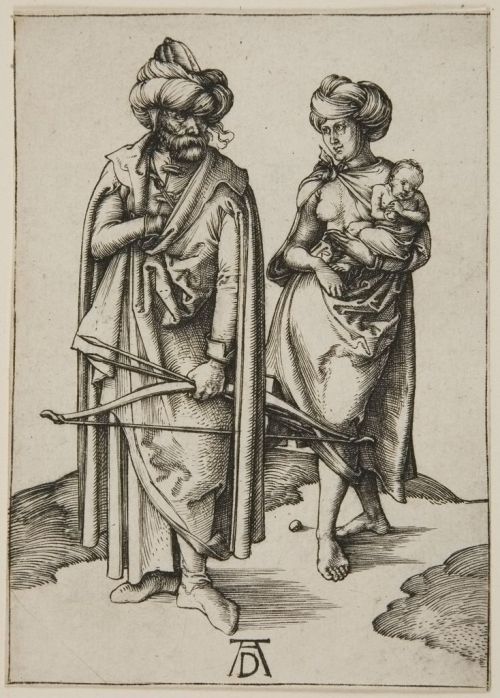
medievalpoc:
Albrecht Dürer
A Turkish Family
Germany (c.1500)
Woodcut/Print
Harvard Art Museums
renaissancearta turkish familygermanyalbrecht durerhistory
September302014
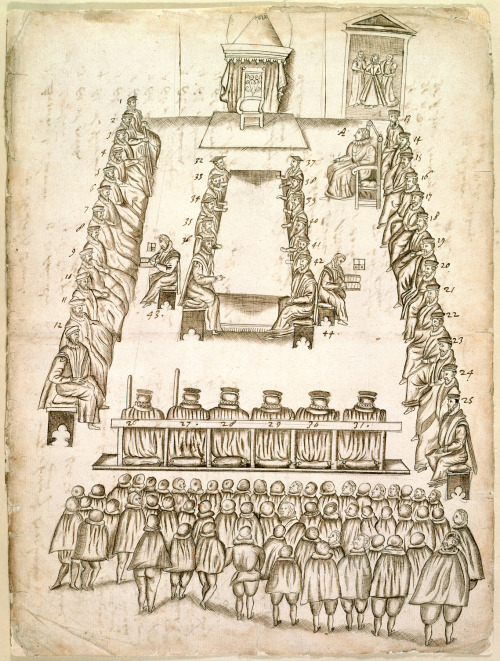
fyeah-history:
Drawing of the trial of Mary, Queen of Scots, 14–15 October 1586
renaissancemary queen of scotsscotlandenglandhistorydrawingart
12PM

kayeberrie:
“In consequence of her marriage with the Dauphin, Mary ordered a new coinage to be struck at her royal mint in the Canongate, Edinburgh, with her regal cypher united with that of her consort, and surmounted with a crown supported with double crosslets, and the motto “Fecit utraque unum, 1558, R.” with the legend, “Franciscus et Mar. D.G. Scotor. R.R.”
- Agnes Strickland, The Life of Mary Queen of Scots, Volume I
The motto fecit utraque unum is taken from the Latin translation of Ephesians 2:14, which reads ipse est enim pax nostra qui fecit utraque unum:
For he is our peace, who have made both one.
mary queen of scotsscotlandrenaissancefrancehistorycoinage
September292014
“Then let us have our Libertie againe,
And challendge to your selves no Sov’raigntie;
You came not in the world without our paine,
Make that a barre against your crueltie;
Your fault beeing greater, why should you disdaine
Our beeing your equals, free from tyranny?
If one weake woman simply did offend,
This sinne of yours, hath no excuse, nor end.” Aemilia Lanyer, “Eve’s Apology” in “Salve Deus Rex Judaeorum” (via fuckyeahrenaissancewomen)
renaissanceliteratureaemilia lanyersalve deus rex judaeorumpoetryenglandhistory
12PM
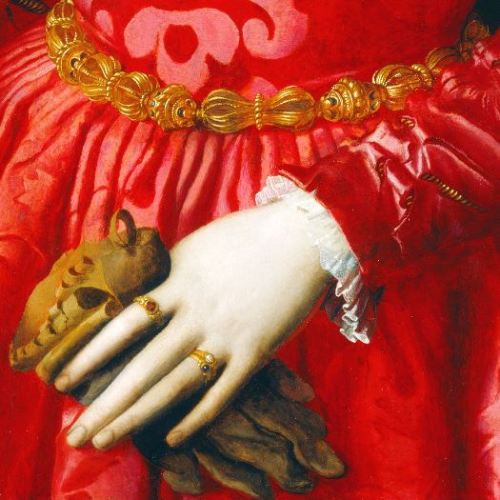
renaissance-art:
Bronzino c. 1540
Young Woman and Her Little Boy (detail)
(via renaissance-art)
agnolo bronzinoyoung woman and her little boyarthistoryrenaissanceitaly
September282014
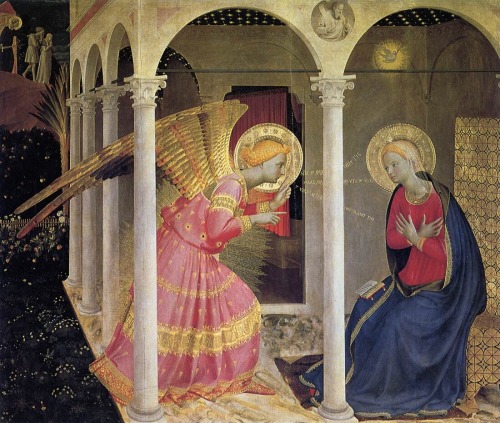
zsofihamori:
Fra Angelico - Annunciation (1434)
fra angelicoannunciationitalyrenaissancearthistory
September202014
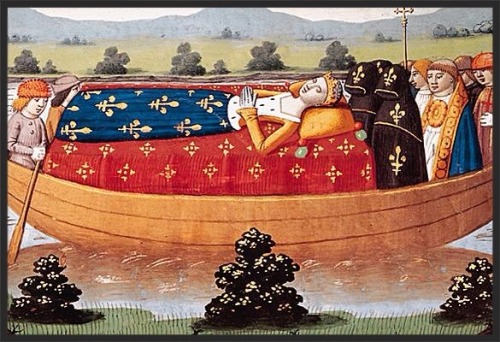
medieval-women:
Queen Isabeau of Bavaria’s 1435 funeral cortege on the Seine.
15th century miniature from the chronicle of Martial d’Auvergne.
Wiki
renaissancehistoryartqueen isabeau of bavaria
September152014

lionofchaeronea:
Pygmalion and Galatea, Bronzino (Agnolo di Cosimo), 1529-30
(via antiqueart)
pygmalion and galateaangnolo bronzinoartrenaissancehistoryitaly12PM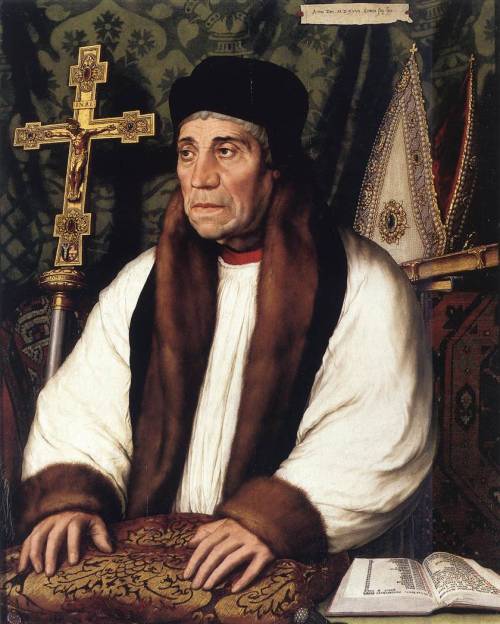
Portrait of William Warham, Archbishop of Canterbury
~Hans Holbein, the Younger
1527
Oil on oak
82 x 67 cm
Musée du Louvre , Paris, Ile-de-France, France
(Source: fuckyeahrenaissanceart) fonte: @edisonmariotti #edisonmariotti His surname may have originated as a nickname, derived from the word blanc in French or blanco in Spanish, both meaning ‘white’. Blanke was part of a wider trend for European rulers to employ African musicians, dating from at least 1194, when turbaned black trumpeters heralded the entry of the Holy Roman emperor Henry VI into Palermo in Sicily. It has been suggested that Blanke arrived in England with Katherine of Aragon when she came to marry Arthur, prince of Wales, in 1501. Between 1507 and 1512 Blanke was one of eight royal trumpeters under the leadership of Peter de Casa Nova. The first payment to ‘John Blanke, the blacke Trumpet’ was made in early December 1507, when he was paid 20s. (8d. a day) for his services in the previous month
The story of John Blanke is one of over 200 episodes available from the Oxford Dictionary of National Biography’s podcast archive. New episodes are released every second Wednesday.
Image: Black trumpeter at Henry VIII’s tournament. Public domain via Wikimedia Commons.

medievalpoc:
Albrecht Dürer
A Turkish Family
Germany (c.1500)
Woodcut/Print
Harvard Art Museums
renaissancearta turkish familygermanyalbrecht durerhistory
September302014

fyeah-history:
Drawing of the trial of Mary, Queen of Scots, 14–15 October 1586
renaissancemary queen of scotsscotlandenglandhistorydrawingart
12PM

kayeberrie:
“In consequence of her marriage with the Dauphin, Mary ordered a new coinage to be struck at her royal mint in the Canongate, Edinburgh, with her regal cypher united with that of her consort, and surmounted with a crown supported with double crosslets, and the motto “Fecit utraque unum, 1558, R.” with the legend, “Franciscus et Mar. D.G. Scotor. R.R.”
- Agnes Strickland, The Life of Mary Queen of Scots, Volume I
The motto fecit utraque unum is taken from the Latin translation of Ephesians 2:14, which reads ipse est enim pax nostra qui fecit utraque unum:
For he is our peace, who have made both one.
mary queen of scotsscotlandrenaissancefrancehistorycoinage
September292014
“Then let us have our Libertie againe,
And challendge to your selves no Sov’raigntie;
You came not in the world without our paine,
Make that a barre against your crueltie;
Your fault beeing greater, why should you disdaine
Our beeing your equals, free from tyranny?
If one weake woman simply did offend,
This sinne of yours, hath no excuse, nor end.” Aemilia Lanyer, “Eve’s Apology” in “Salve Deus Rex Judaeorum” (via fuckyeahrenaissancewomen)
renaissanceliteratureaemilia lanyersalve deus rex judaeorumpoetryenglandhistory
12PM

renaissance-art:
Bronzino c. 1540
Young Woman and Her Little Boy (detail)
(via renaissance-art)
agnolo bronzinoyoung woman and her little boyarthistoryrenaissanceitaly
September282014

zsofihamori:
Fra Angelico - Annunciation (1434)
fra angelicoannunciationitalyrenaissancearthistory
September202014

medieval-women:
Queen Isabeau of Bavaria’s 1435 funeral cortege on the Seine.
15th century miniature from the chronicle of Martial d’Auvergne.
Wiki
renaissancehistoryartqueen isabeau of bavaria
September152014

lionofchaeronea:
Pygmalion and Galatea, Bronzino (Agnolo di Cosimo), 1529-30
(via antiqueart)
pygmalion and galateaangnolo bronzinoartrenaissancehistoryitaly12PM

Portrait of William Warham, Archbishop of Canterbury
~Hans Holbein, the Younger
1527
Oil on oak
82 x 67 cm
Musée du Louvre , Paris, Ile-de-France, France


Nenhum comentário:
Postar um comentário